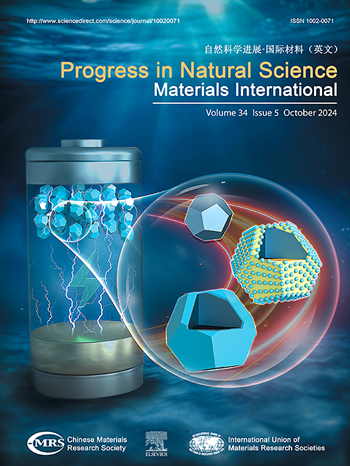再结晶行为对硬板轧制铝/镁/铝复合板晶粒形貌演变和力学性能的双重影响
IF 4.8
2区 材料科学
Q2 MATERIALS SCIENCE, MULTIDISCIPLINARY
Progress in Natural Science: Materials International
Pub Date : 2024-10-01
DOI:10.1016/j.pnsc.2024.07.019
引用次数: 0
摘要
提高结合强度、优化微观结构和改善性能是制造异质复合板的有效策略。在这项研究中,通过硬板轧制(HPR)制造了铝/镁/铝复合板,轧制量减少了 40% 到 80%。研究主要集中在轧制过程中轧制动态再结晶(DRX)行为对 AZ31 镁合金板晶粒形态演变和机械性能影响的基板上。研究结果表明,当压缩量为 60% 时,复合板表现出极限拉伸强度 (UTS)、12.5% 的最大伸长率 (EL) 以及更好的界面结合。对比分析表明,DRX 出现在镁侧,从而形成了小的 DRX 晶粒。随着还原度的增加,DRX 变得更加容易,导致 DRX 化晶粒的比例从最初的上升到随后的下降。细小晶粒的增加阻碍了位错运动,从而强化了复合板。此外,再结晶程度的提高还能促进非基底滑移的产生,增强金属板的塑性。这项研究为生产高质量的镁铝复合板提供了宝贵的科学指导和技术帮助。本文章由计算机程序翻译,如有差异,请以英文原文为准。
Double effects of recrystallization behavior on grain morphology evolution and mechanical properties of Al/Mg/Al composite plate by hard plate rolling
Enhancing the bonding strength, optimizing the microstructure and refining the properties represent effective strategies for the fabrication of heterogeneous composite plates. In this study, composite plates of Al/Mg/Al were fabricated through hard plate rolling (HPR) with a reduction in rolling ranging from 40 % to 80 %. The research primarily concentrates on the substrate in the influence of rolling dynamic recrystallization (DRX) behavior on the grain morphology evolution and mechanical properties of AZ31 magnesium alloy sheets during the process. The findings indicate that at a compression amount of 60 %, the composite plate exhibits an ultimate tensile strength (UTS), a maximum elongation (EL) of 12.5 %, and improved interface bonding. Comparative analysis reveals the occurrence of DRX on the Mg side, resulting in the formation of small DRXed grains being generated. With an increase in reduction, DRX is facilitated, leading to an initial rise and subsequent decline in the proportion of DRXed grains. The proliferation of fine grains hinder dislocation movement, thereby reinforcing composite plate. Moreover, an elevation in the degree of recrystallization enhances the initiation of non-basal slip and enhances the plasticity of sheet metal. This study offers valuable scientific guidance and technical assistance for the production of forming high-quality Mg–Al composite plates.
求助全文
通过发布文献求助,成功后即可免费获取论文全文。
去求助
来源期刊
CiteScore
8.60
自引率
2.10%
发文量
2812
审稿时长
49 days
期刊介绍:
Progress in Natural Science: Materials International provides scientists and engineers throughout the world with a central vehicle for the exchange and dissemination of basic theoretical studies and applied research of advanced materials. The emphasis is placed on original research, both analytical and experimental, which is of permanent interest to engineers and scientists, covering all aspects of new materials and technologies, such as, energy and environmental materials; advanced structural materials; advanced transportation materials, functional and electronic materials; nano-scale and amorphous materials; health and biological materials; materials modeling and simulation; materials characterization; and so on. The latest research achievements and innovative papers in basic theoretical studies and applied research of material science will be carefully selected and promptly reported. Thus, the aim of this Journal is to serve the global materials science and technology community with the latest research findings.
As a service to readers, an international bibliography of recent publications in advanced materials is published bimonthly.

 求助内容:
求助内容: 应助结果提醒方式:
应助结果提醒方式:


